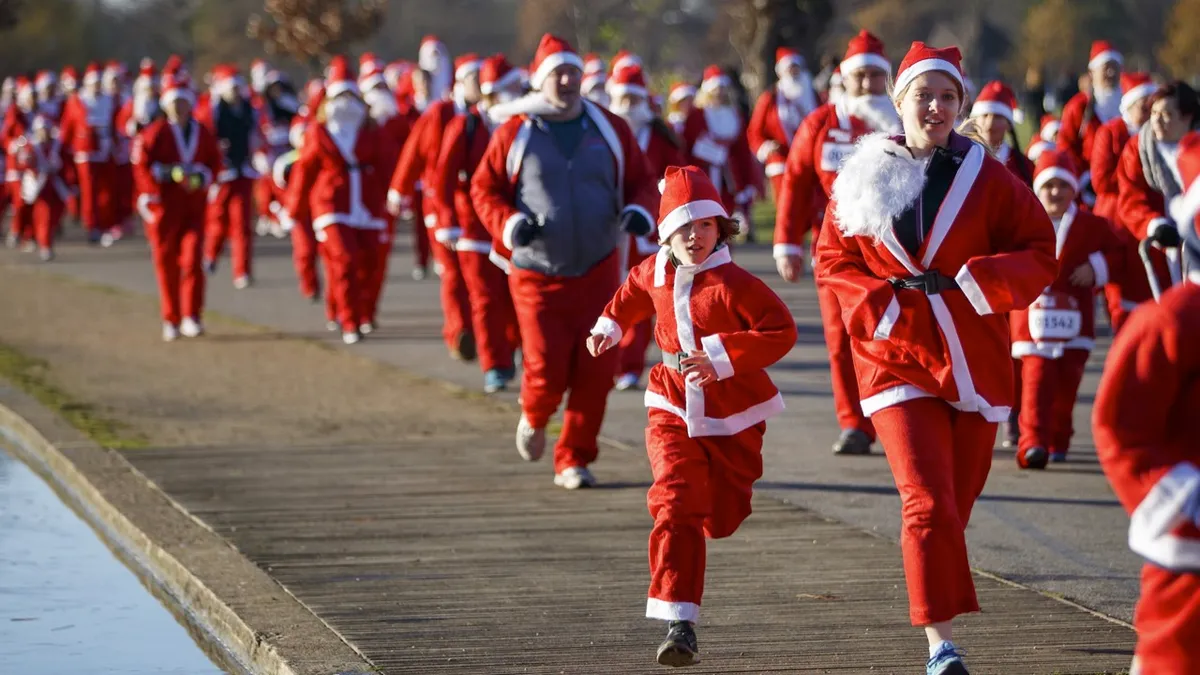Every Christmas Santa Claus departs from his Arctic Circle abode on a mission to deliver presents to millions of homes around the world. The magnitude of his delivery schedule is unique – Santa faces the prospect of having to deliver to roughly 350 million homes on Christmas Eve!
To help fulfil the world’s delivery expectations, Santa cleverly uses the world’s international time zones. He starts his deliveries at Kiritimati or Christmas Island in the Pacific Ocean and travels westwards around the globe, delivering to Asia, Europe and America before concluding his deliveries by visiting American Samoa in the Pacific.
His shrewd use of the time zones affords him about 34 hours for his deliveries but his delivery schedule still works out at approximately 3,000 homes per second. Although Santa uses wormhole technologies and teleportation devices to avoid bad weather and speed up his journey, 3,000 homes every second seems insurmountable. Undoubtedly Santa needs help.
Santa and the elf-scientists have been more than aware of this potential problem for many years, and have formulated an ingenious scientific approach. Santa gets help from Santa!
Christmas presence
Prior toChristmas, our towns, shopping centres and public halls are occupied by Santa Clauses. When I was younger my parents told me that the role of these Helper Santa Clauses was to meet children around the world, hear their present requests and then bring the list of present requests back to the Arctic workshops. This list was then checked against the letters arriving from children globally. In effect, Santa double-checks the orders.
But the function of the Helper Santa Clauses goes beyond just meeting children at shopping centres and list making. Once they return to the Arctic workshops on Christmas Eve the Helpers fulfil their true role – to deliver presents alongside Santa Claus on Christmas Eve. Rather than a single sleigh departing a North Pole workshop hundreds of sleighs, with their own reindeer of course, leave together on one of the greatest round-the-world expeditions of all time.
With the present delivery schedule now shared among the Helper Santa Clauses, every Helper Santa Claus, and Santa Claus himself, have adequate time for toilet breaks and naps. The elves have even devised a rota for the Helper Santa Clauses.
Read more about Christmas:
- What happens to your body after eating Christmas dinner?
- Is Christmas food and drink putting our health at risk?
- 8 maths hacks to master Christmas
But where do the Helper Santa Clauses come from? How does Santa Claus recruit them? Thanks to the ingenuity of Santa Claus and the elf-scientists they have developed the Multiple Helper Santa Claus (MHSC) system – the most advanced 3D bioprinter system on the planet.3D printinghas been around since the early 1980s and has been used in many fields such as engineering, medicine and toy production. You can even 3D printornate chocolatesat home if you want!
But 3D bioprinting is the next big application for 3D printing and the prospect of printing biological tissues and even complete organs. One of the most advanced 3D bioprinting approaches at the moment, besides Santa’s MHSC system, is ITOP, which stands for Integrated Tissue-Organ Printer and has been developed by a research team led by Anthony Atala at the Wake Forest Institute for Regenerative Medicine (WFIRM) in North Carolina, USA.
To print tissue the ITOP system first prints a biodegradable scaffold in which the biological cells, in the form of a hydrogel, are printed. Naturally, if the cells do not receive water, oxygen and nutrients their chances of survival are practically zero. Thus during the 3D printing process, biodegradable microchannels are also created. Over time the tissue develops its own blood vessel network and the microchannels vanish.
The Integrated Tissue-Organ Printing (ITOP) System at the beginning, middle and end stages of printing a bone structure to replace a jaw defect© Wake Forest Institute for Regenerative Medicine
ITOP has already been used to print ears and muscle tissue. One of the main goals would be replacement organ printing. Imagine if, in the future, we could print entire replacement kidneys, which is the most transplanted organ in the world. There would be no more dialysis treatments or waiting for donor kidneys for those people suffering from kidney failure or diseases.
Santa cells
Now Santa’s Multiple Helper Santa Claus (MHSC) system is the ultimate 3D bioprinter. By using undifferentiated adult stem cells from his body, Santa and the elves can produce all of the different cell types – from blood cells to skin cells and from bone cells to brain cells. The cell types are then loaded into the MHSC and after a few moments a newly printed, and clothed, Helper Santa Claus emerges. A non-damaging electrical shock is used to kick-start heart and brain activity.
The difference between all of the Helper Santa Clauses is due to slight miscalculations on the part of the elf-scientists. From time to time there are too many fat cells and a very fat Santa emerges. On other occasions there are too few bone cells and a small Santa is rolled out. Sometimes Santa’s beardseems a little looser than normal.

But the importance of the Helper Santa’s cannot be understated. Without their assistance, Santa Claus would be faced with a near-impossible task. A flock of present-laden sleighs is destined to fly around the world this Christmas delivering presents with an efficiency that must make most logistical companies quite envious. Well, this is Santa Claus – innovator, inventor, scientist, present-deliverer and genius.
So this Christmas morning, don’t just thank Santa Claus for the presents left under the tree. Be sure to thank the Helper Santa Clauses, the numerous reindeer and Santa’s dedicated team of elf-scientists at his Arctic workshops. It’s a team effort and there is no “I” in team. That’s something that Santa Claus knows very well.
Secret Science of Santa Claus by Barry W. Fitzgerald is available to buy now (€16.95)